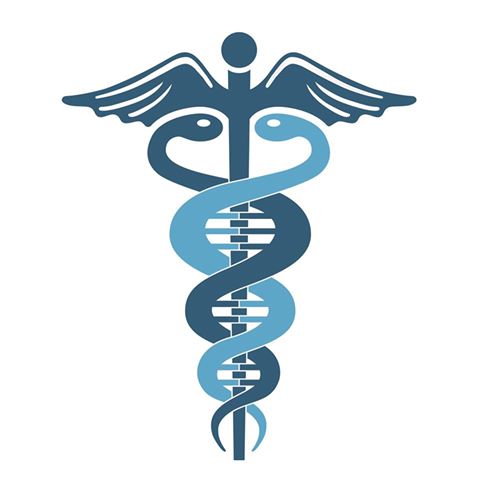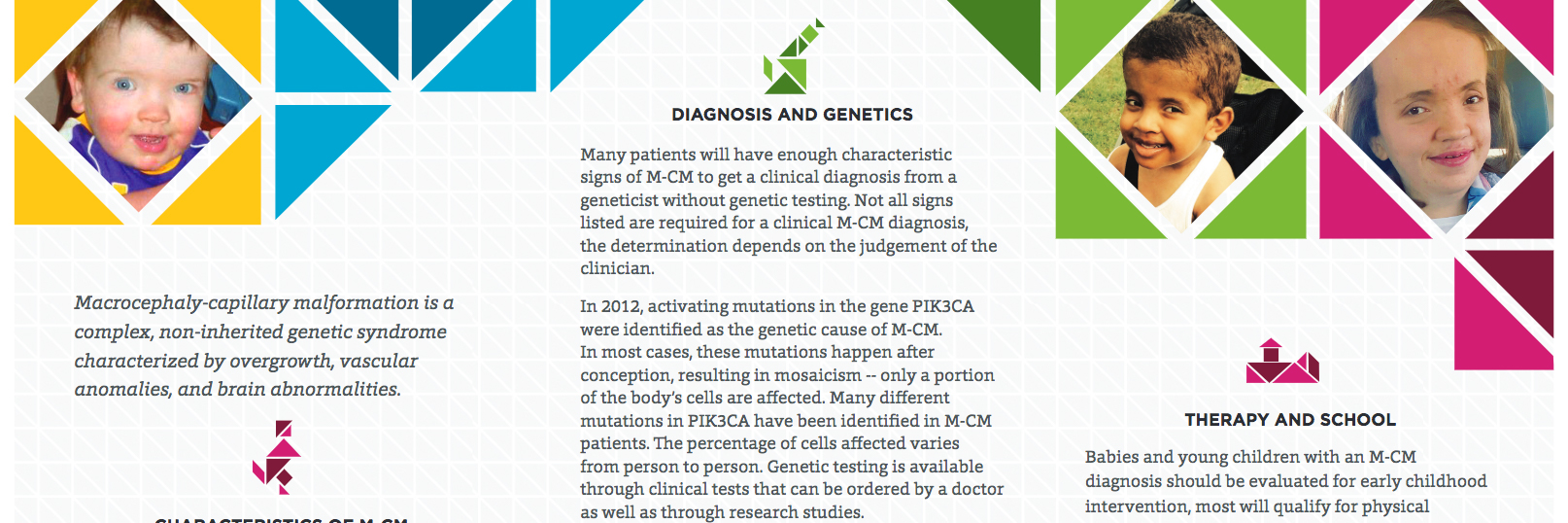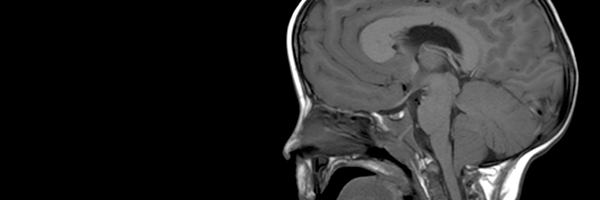Syndrome Description
Learn more about M-CM



Genetic testing for suspected M-CM / MCAP is more complicated than other kinds of genetic testing. Since testing for M-CM / MCAP occurs rarely compared to more routine genetic testing, many healthcare providers are unfamiliar with it. As a result, some patients end up having testing performed on the wrong sample types and/or using the wrong test method. To avoid misdiagnosis, wasted money, or a missed opportunity to learn about the cause of a patient’s condition, we suggest having proactive discussions about genetic test selection with your healthcare provider.
The recommended tests meet acceptable standards of quality for most patients undergoing testing for M-CM / MCAP. We have selected these tests because
We all have billions of DNA molecules inside each of our cells, which we name with the letters A, T, G, and C. These DNA molecules string together to form clusters called genes. Genes contain instructions that tell our body how to grow and produce the components necessary to make our bodies function. We receive two sets of DNA, one from our mother and one from our father. The DNA is packaged inside each of our cells in microscopic structures called chromosomes.
If you compare the DNA of one person to that of another, you will see many differences. For example, person might have an “A” in a certain location while another person has a “G”. Most of these variations in our genes are harmless. However, sometimes a variant in a person’s DNA will cause a gene to work incorrectly. We call these variants “mutations” if we believe they have a strong link to a disease. In M-CM / MCAP, more than 40 unique mutations have been found in a gene called PIK3CA. If we know the specific mutation a person has, sometimes that can help to better understand a disease.
Genetic mutations can change the instructions a gene provides the body, or they can stop a gene from working altogether. In M-CM / MCAP and PIK3CA-related overgrowth conditions, mutations increase the activity of the gene and are called “activating” mutations.
We often think of genetic mutations as being inherited from a parent. When a genetic mutation is inherited, it is present from birth and is found in most or all of the cells in a person’s body. We call these types of mutations “germline” mutations.
Genetic mutations can also occur at random after conception but very early in fetal development. When this happens, the mutation has not been inherited, and it is not found in every cell (or even every tissue) of the body. We refer to this phenomenon as “mosaicism.” Most reported cases of M-CM / MCAP are caused by mosaic mutations - the mutation is not found in all of the person’s cells. This has important implications when it comes to looking for the causative mutation in a person with M-CM / MCAP.
Select appropriate samples for testing. A good start is to evaluate the patient to determine what parts of the patient’s body are affected. Fresh tissue from a punch biopsy or surgical procedure of an affected area of the body is the best kind of sample for testing as it has been shown to provide the highest percentage of affected cells. Sometimes a buccal swab (cheek swab) can be tried instead of fresh tissue, but mutations are less likely to be detected. Blood may be requested for comparison testing, but testing blood alone is unlikely to be productive and is not recommended.
The method of testing used should be ‘ultra deep’ sequencing with high coverage of the targeted genes. Mosaic mutations can be difficult to detect. A sequencing test reads the same DNA letters over and over again many times to be confident that they will detect a mosaic mutation which occurs at levels as low as 1% in a tissue sample. The test method should be ‘ultra deep’ sequencing. “Sequencing” refers to a test method that can identify every single DNA letter in a gene of interest. ‘Ultra-deep’ sequencing is a method that reads letters in the gene over, and over, and over again so that the end result can be trusted as reliable. The number of times a sequencing test is able to identify a specific DNA letter in the genome is called “coverage”. Usually the lab will be able to inform you what their average coverage is for a genetic test.
The test should examine the entirety of the genes targeted, as well as flanking DNA sequences. More than 40 different disease-causing mutations have been found in the PIK3CA gene. Genetic tests that do not look at a gene in its entirety run the risk of missing some mutations. Many genetic tests include panels of more than one gene related to a person’s symptoms. For patients with a suspected diagnosis of M-CM / MCAP, make sure that the PIK3CA gene is present on the panel being used and that the entire gene is being fully sequenced.
A small proportion of people with an M-CM / MCAP diagnosis carry germline (not mosaic) mutations in PIK3CA. Inheritance is possible when there is a germline mutation, though all currently known germline cases are thought to be sporadic, or not inherited. It is important to distinguish mosaic cases from germline cases so that families can accurately assess the risk of having affected children in the future.
Your genetic testing could reveal several types of results.
Positive. A positive result means that the lab found a mutation believed to cause the person’s symptoms. If you receive a positive result, there are some important details to note in your report:
Negative. A negative result means that the lab did not find a mutation believed to cause the person’s symptoms in the samples provided. If the samples were not optimal, you may choose to retest with different samples. Unlike most other genetic tests, re-testing for mutations in patients with M-CM / MCAP may provide different results with different samples because of the mosaic nature of the mutations that cause this condition. Sometimes a sample that comes from a part of the body that may look like it is “affected” actually has such low levels of mosaicism that a mutation cannot be detected by a genetic test.
Uncertain. From time to time, the lab will find a gene variant they have not seen before or know little about. These are called “variants of uncertain significance” or VUSes. One possibility is that a VUS is normal, ie. not related to your disease. Another possibility is that future studies will find a link between a VUS and your disease. If your result is a VUS, it is important to have a discussion with your healthcare provider and/or the genetic testing lab. Together, you should develop a plan for how you will be notified when more is learned about a VUS.
Unexpected findings. PIK3CA and other genes associated with overgrowth conditions are sometimes tested for using panels that sequence many genes at once. Any test that looks at more than one gene can find variants in more than one gene. However, not all gene variants found by a test will have health implications. It is important to show your test results to a doctor who is familiar with M-CM / MCAP and PIK3CA-related overgrowth conditions, who can help you interpret unexpected findings in genes other than PIK3CA.
Whatever your genetic test results say, you should obtain a copy of your genetic test report for your own records. The genetic test report contains important information such as:
This type of information may not be recorded anywhere else. It could be helpful in the future, when more is known about the genetics of M-CM / MCAP and PIK3CA-related overgrowth conditions.
When performed correctly, genetic testing for M-CM / MCAP can have the following benefits:
Establishing eligibility for clinical trials. A small but growing number of clinical trials for PIK3CA-related conditions (and other overgrowth conditions) require genetic test results to establish a patient’s eligibility for a trial. These trials are highly targeted to specific genetic pathways. Knowing a patient’s genetic mutation status may also help patients avoid clinical trials that are dangerous or unlikely to help them.
Providing accurate information about the risk of disease recurrence in a family. A small proportion of known cases of M-CM / MCAP are caused by germline mutations. Individuals who carry germline mutations in PIK3CA typically have a 50% chance of passing the mutation on with each pregnancy. Family members of patients who carry germline mutations should seek genetic counseling to learn more about their specific recurrence risks.
Getting the most appropriate medical management. Individuals with M-CM / MCAP or PIK3CA-related overgrowth conditions have features that overlap with the features of patients who have other conditions, such as PTEN-Related Hamartoma Syndrome. Individuals with these disorders have some shared experiences, but they also have distinct needs. While the results of genetic testing do not always offer clarity about an individual’s diagnosis, genetic testing can help point doctors in the right direction when caring for your child - if not today, then possibly in the future.
Stay tuned. As more is learned about M-CM / MCAP and PIK3CA-related conditions, there may be additional benefits to performing genetic testing in affected individuals.
This guidance was researched and written by Leila Jamal, ScM, PhD, CGC. Julie C. Sapp, ScM, CGC provided consultation. The M-CM Network surveyed participants in our contact registry and in the M-CM Facebook group about their experiences with and understanding of genetic testing that they had participated in. Dr. Jill Clayton-Smith provided valuable feedback. Christy Collins edited final revisions. We are grateful for the professional and patient advice that contributed to this article. Please let us know if you have suggestions or questions.
Kuentz P, St-onge J, Duffourd Y, et al. Molecular diagnosis of PIK3CA-related overgrowth spectrum (PROS) in 162 patients and recommendations for genetic testing. Genet Med. 2017;19(9):989-997.

Learn more about M-CM

Order brochures or download a PDF

Guidelines from published research literature

Explore the results of a patient survey conducted in 2012

Explore the research literature related to M-CM

An extensive list of resources